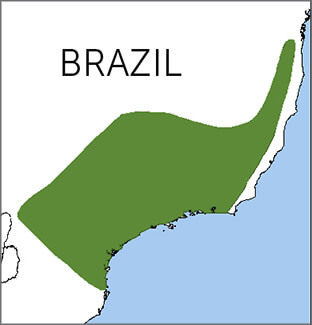 The Pin-tailed Manakin is the only member of its genus and is found only in Brazil. Like other manakins such as the Araripe, it is sexually dimorphic: Males have flashy plumage, while females are a dull greenish color. These small, short-tailed birds tend to be solitary but can occur within mixed-species flocks.
The Pin-tailed Manakin is the only member of its genus and is found only in Brazil. Like other manakins such as the Araripe, it is sexually dimorphic: Males have flashy plumage, while females are a dull greenish color. These small, short-tailed birds tend to be solitary but can occur within mixed-species flocks.
Like many species of the dwindling Atlantic Forest region, this bird's population is likely in decline because of ongoing habitat destruction. Pin-tailed Manakins can be found in the Mata do Passarinho reserve (also known as Stresemann's Bristlefront Reserve), where ABC and Fundação Biodiversitas, supported by PetroBras, have protected 1,468 acres. Threatened species such as the Stresemann's Bristlefront and Banded Cotinga occur here, as well as Gilt-edged Tanager and Saffron Toucanet.
Male manakins are known for their elaborate group courtship displays, which often take place on gathering grounds called "leks." Female manakins visit these leks to pick a mate from the group of displaying males.
Sign up for ABC's eNews to learn how you can help protect birds

Pin-tailed Manakin by Aisse Gaertner
Unlike many in their family, male Pin-tailed Manakins "dance" alone, making whirring and snapping sounds with specialized wing and tail feathers and flashing their bright red rump feathers during short, rapid flights.
Other birds that gather in leks include the Gunnison Sage-Grouse, found only in a small range in the United States, and the Buff-breasted Sandpiper, a long-distance migrant that breeds in the far north and winters as far south as Argentina.
Donate to support ABC's conservation mission!



















































